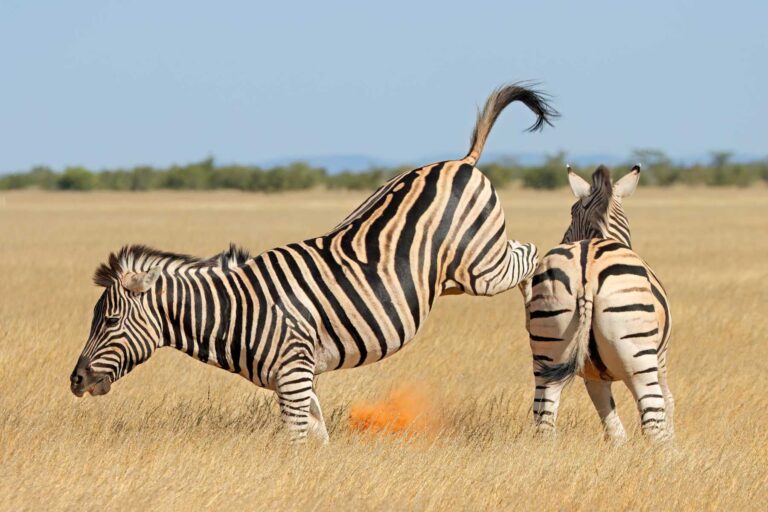Zebras on the Menu: A Deep Dive into Their Predators
Zebras, those magnificent creatures adorned with striking black and white stripes, roam the grasslands of Africa, capturing the attention of nature enthusiasts worldwide. Yet, beneath their dazzling appearance lies a story of survival and adaptation against various predators. In this exploration, we unravel the tapestry of the animal kingdom’s relentless pursuit of zebras, understanding the intricacies of these predators’ strategies and their impact on zebra populations.
Predators of Zebras
Though possessing a certain allure, zebras are far from invincible in the wild. Various carnivores and reptiles have evolved to view them not as fellow beings but as potential meals. Let’s take a closer look at the cast of characters in the drama of zebra predation.
- Carnivores
- Lions
Lions, the majestic kings of the savannah, reign supreme among zebra predators. These big cats often employ stealth and teamwork when hunting zebras. A pride in working together can increase the chances of a successful hunt, as zebras are agile and quick to respond to threats.
- Hyenas
Hyenas, with their reputation for cunning and scavenging, also make zebras part of their culinary repertoire. They are known for their ability to wear down a zebra during a relentless pursuit, taking advantage of their endurance and teamwork to secure a meal.
- Leopards
Leopards, though solitary hunters, are opportunistic and can ambush zebras with astonishing precision. Their agility and ability to climb trees make them formidable predators, able to surprise their striped prey from above.
- Cheetahs
Cheetahs, the fastest land animals, rely on their incredible speed to chase down zebras. Although their success rate is lower compared to larger predators, their bursts of speed make them a force to be reckoned with in the race for survival.
- Wild Dogs
A pack of wild dogs, also known as African-painted dogs, showcases collaborative hunting methods. They coordinate their efforts to separate a zebra from its herd, increasing the likelihood of a successful hunt.
- Crocodiles
While it may seem surprising, crocodiles can threaten zebras, particularly during river crossings. Crocodiles patiently lurk beneath the water’s surface, waiting for the opportune moment to strike when zebras are most vulnerable.
- Large Birds of Prey
Large birds of prey, such as eagles and vultures, may target young or weak zebras. These aerial predators use their keen eyesight and powerful talons to snatch up unsuspecting individuals, contributing to the multifaceted nature of zebra predation.
Hunting Strategies
Survival in the wild demands a variety of tactics, and zebra predators have evolved distinct strategies to secure their next meal.
- Group Hunting
Lions and hyenas exemplify the power of group hunting. Working together, they create a formidable force to overcome the zebras’ defensive maneuvers. The cooperation within a pride or a hyena clan significantly enhances the chances of a successful hunt.
Comparison of Group Hunting Tactics
| Predator | Group Size | Cooperative Tactics | Notable Achievements |
| Lions | Pride | Ambush, Surround, and Chase | Successful hunts in the open savannah |
| Hyenas | Clan | Endurance and Teamwork | Effective at wearing down zebras |
| Wild Dogs | Pack | Coordination and Strategy | Swift and well-coordinated attacks |
- Ambush Tactics
Leopards, with their solitary nature, excel in ambush tactics. They patiently wait for the opportune moment to strike, utilizing their camouflage and stealth to get close to zebras before launching a surprise attack.
Notable Ambush Predators
| Predator | Solitary or Group | Ambush Tactics | Preferred Hunting Grounds |
| Leopards | Solitary | Tree Ambushes and Stealth | Forested areas and grasslands |
| Cheetahs | Solitary | High-speed Pursuit and Surprise | Open savannah and grassy landscapes |
| Crocodiles | Solitary | Submerged Ambush from Water | Riverbanks and watering holes |
- Pursuit and Stamina Hunting
With their unmatched speed, cheetahs showcase the pursuit and stamina hunting strategy. They rely on their incredible bursts of speed to quickly close the gap between them and their prey, overwhelming zebras with their velocity.
Pursuit and Stamina Hunters
| Predator | Speed | Pursuit Tactics | Success Rate |
| Cheetahs | 70 mph | High-speed Chase and Sprint | High success in short bursts |
| Lions | 35 mph | Coordinated Pursuit and Surround | Lower success but strategic |
| Wild Dogs | 37 mph | Group Pursuit and Endurance | Moderate success with strategy |
Impact on Zebra Populations
The delicate balance of predator-prey dynamics plays a crucial role in shaping ecosystems. The predators’ influence on zebra populations extends beyond the immediate act of hunting.
- Regulation of Zebra Populations
As primary herbivores, zebras play a vital role in shaping vegetation and maintaining the balance within their ecosystems. The presence of predators helps regulate zebra populations, preventing overgrazing and ensuring a healthier environment for other species.
- Evolutionary Adaptations of Zebras
Constant pressure from predators has led to the evolution of various adaptations in zebras. Their keen senses, such as exceptional eyesight and acute hearing, aid in detecting potential threats. Zebra herds also exhibit a synchronized defense mechanism, where individuals form a united front against attackers, enhancing their chances of survival.
Conclusion
In the intricate dance of survival and predation, zebras hold a central role as both prey and participants in the grand tapestry of the African savannah. Understanding the diverse array of predators and their hunting strategies gives us a glimpse into the complex web of life. The predator-prey dynamics shape zebra populations and contribute to the resilience and adaptability of these remarkable striped equids in the face of relentless challenges. So, the next time you marvel at a zebra’s elegant stripes, remember the untold stories of survival etched into each black-and-white pattern.


